A rubric ensures that a project supports your learning objectives by defining the criteria students will be evaluated on and listing the evidence that is to be produced for each criteria.
 If you have a favorite rubric resource, please share in a comment for the rest of us! One of my favorites (which is free) is rubistar. Rubistar allows you to find, create and share rubrics. You can search examples or browse by subject area. If your project needs a little spicing up, you can visit the inspiration page for help.
If you have a favorite rubric resource, please share in a comment for the rest of us! One of my favorites (which is free) is rubistar. Rubistar allows you to find, create and share rubrics. You can search examples or browse by subject area. If your project needs a little spicing up, you can visit the inspiration page for help.When creating a rubric on rubistar, you don’t have to start with a blank slate. The site helps you find a similar, customizable rubric to help you start. Here’s the beauty: there are drop down menus of criteria choose from (or you can enter your own). There are also presets for the evidence columns and you can choose how you want to weight each criteria. When you’re finished, you can save, print and go!
Classroom Engagement Tip for November 10, 2008





